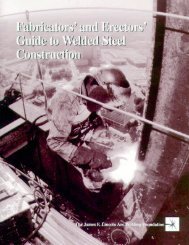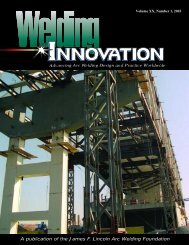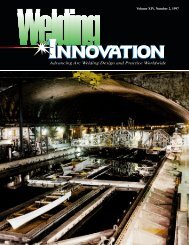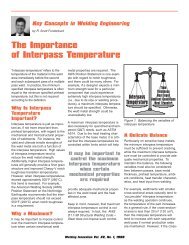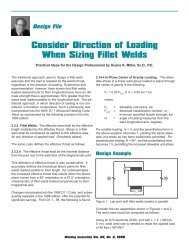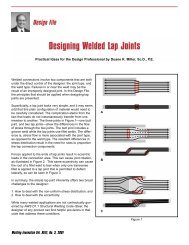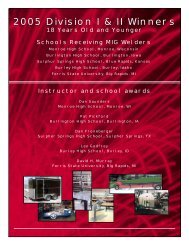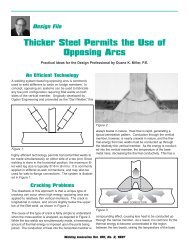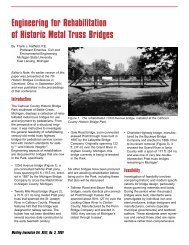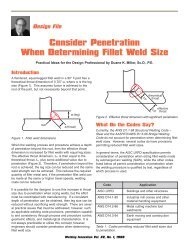A publication of the James F. Lincoln Arc Welding Foundation
A publication of the James F. Lincoln Arc Welding Foundation
A publication of the James F. Lincoln Arc Welding Foundation
You also want an ePaper? Increase the reach of your titles
YUMPU automatically turns print PDFs into web optimized ePapers that Google loves.
attack, it was estimated that only 15<br />
percent <strong>of</strong> <strong>the</strong> debris had been<br />
removed, and it was estimated that it<br />
would take a year to clear <strong>the</strong> site.<br />
Forensic Engineering<br />
Among <strong>the</strong> concerns engineers had<br />
about <strong>the</strong> clean-up operation was how<br />
<strong>the</strong> removal <strong>of</strong> debris might affect <strong>the</strong><br />
stability <strong>of</strong> <strong>the</strong> ground around <strong>the</strong> site.<br />
Because <strong>the</strong> land on which <strong>the</strong> World<br />
Trade Center was built had been part<br />
<strong>of</strong> <strong>the</strong> Hudson River, an innovative<br />
barrier had to be developed at <strong>the</strong><br />
time <strong>of</strong> construction to prevent river<br />
water from flowing into <strong>the</strong> basement<br />
<strong>of</strong> <strong>the</strong> structures. This was done with<br />
<strong>the</strong> construction <strong>of</strong> a slurry wall, in<br />
which <strong>the</strong> water was held back by a<br />
deep trench filled with a mudlike mixture<br />
until a hardened concrete barrier<br />
was in place. The completed structure<br />
provided a watertight enclosure, which<br />
came to be known as <strong>the</strong> “bathtub”<br />
within which <strong>the</strong> World Trade Center<br />
was built. The basement floors <strong>of</strong> <strong>the</strong><br />
twin towers acted to stabilize <strong>the</strong> bathtub,<br />
but <strong>the</strong>se were crushed when <strong>the</strong><br />
towers broke up and collapsed into <strong>the</strong><br />
enclosure. Early indications were that<br />
<strong>the</strong> bathtub remained intact, but in<br />
order to be sure its walls do not collapse<br />
when <strong>the</strong> last <strong>of</strong> <strong>the</strong> debris and<br />
thus all <strong>the</strong> internal support is<br />
removed, vulnerable sections <strong>of</strong> <strong>the</strong><br />
concrete wall were being tied back to<br />
<strong>the</strong> bedrock under <strong>the</strong> site even as <strong>the</strong><br />
debris removal was proceeding.<br />
Atop <strong>the</strong> pile <strong>of</strong> debris, <strong>the</strong> steel<br />
beams and columns were <strong>the</strong> largest<br />
and most recognizable parts in <strong>the</strong><br />
wreckage. The concrete, sheetrock<br />
and firepro<strong>of</strong>ing that were in <strong>the</strong> building<br />
were largely pulverized by <strong>the</strong> collapsing<br />
structure, as evidenced by <strong>the</strong><br />
ubiquitous dust present in <strong>the</strong> aftermath.<br />
(A significant amount <strong>of</strong><br />
asbestos was apparently used only in<br />
<strong>the</strong> lower floors <strong>of</strong> one <strong>of</strong> <strong>the</strong> towers,<br />
bad publicity about <strong>the</strong> material having<br />
accelerated during <strong>the</strong> construction <strong>of</strong><br />
<strong>the</strong> World Trade Center. Never<strong>the</strong>less,<br />
in <strong>the</strong> days after <strong>the</strong> collapse, <strong>the</strong><br />
All <strong>of</strong> <strong>the</strong> speculations<br />
about <strong>the</strong> mechanism<br />
<strong>of</strong> collapse are in fact<br />
hypo<strong>the</strong>ses<br />
once-intolerant Environmental<br />
Protection Agency declared <strong>the</strong> air<br />
safe.) The grille-like remains <strong>of</strong> <strong>the</strong><br />
buildings’ facades, towering precariously<br />
over what came to be known as<br />
Ground Zero, became a most eerie<br />
image. Though many argued for leaving<br />
<strong>the</strong>se ca<strong>the</strong>dral wall-like skeletons<br />
standing as memorials to <strong>the</strong> dead,<br />
<strong>the</strong>y posed a hazard to rescue workers<br />
and were in time torn down and<br />
carted away for possible future reuse<br />
in a reconstructed memorial. As is<br />
<strong>of</strong>ten <strong>the</strong> case following such a<br />
tragedy, <strong>the</strong>re was also some disagreement<br />
about how to treat <strong>the</strong><br />
wreckage generally. Early on, <strong>the</strong>re<br />
was clearly a need to remove as much<br />
<strong>of</strong> it from <strong>the</strong> site as quickly as possible<br />
so that what survivors <strong>the</strong>re might<br />
be could be uncovered. This necessitated<br />
cutting up steel columns into<br />
sections that could fit on large flatbed<br />
trucks. Even <strong>the</strong> disposal <strong>of</strong> <strong>the</strong> wreckage<br />
presented a problem. Much <strong>of</strong> <strong>the</strong><br />
steel was marked for immediate recycling,<br />
but forensic engineers worried<br />
that valuable clues to exactly how <strong>the</strong><br />
structures collapsed would be lost.<br />
All <strong>of</strong> <strong>the</strong> speculations <strong>of</strong> engineers<br />
about <strong>the</strong> mechanism <strong>of</strong> <strong>the</strong> collapse<br />
are in fact hypo<strong>the</strong>ses, <strong>the</strong>ories <strong>of</strong><br />
what might have happened. Although<br />
computer models will no doubt be constructed<br />
to test those hypo<strong>the</strong>ses and<br />
<strong>the</strong>ories, actual pieces <strong>of</strong> <strong>the</strong> wreckage<br />
may provide <strong>the</strong> most convincing<br />
confirmation that <strong>the</strong> collapse <strong>of</strong> <strong>the</strong><br />
structures did in fact progress as<br />
hypo<strong>the</strong>sized. Though <strong>the</strong> wreckage<br />
may appear to be hopelessly jumbled<br />
and crushed, telltale clues can survive<br />
among <strong>the</strong> debris. Pieces <strong>of</strong> partially<br />
melted steel, for example, can provide<br />
<strong>the</strong> means for establishing how hot <strong>the</strong><br />
fire burned and where <strong>the</strong> collapse<br />
might have initiated. Badly bent<br />
columns can give evidence <strong>of</strong> buckling<br />
before and during collapse. Even <strong>the</strong><br />
scratches and scars on large pieces <strong>of</strong><br />
steel can be useful in determining <strong>the</strong><br />
sequence <strong>of</strong> collapse. This will be <strong>the</strong><br />
task <strong>of</strong> teams <strong>of</strong> experts announced<br />
shortly after <strong>the</strong> tragedy by <strong>the</strong><br />
American Society <strong>of</strong> Civil Engineers<br />
and <strong>the</strong> Federal Emergency<br />
Management Agency. Also in <strong>the</strong><br />
immediate wake <strong>of</strong> <strong>the</strong> collapse, <strong>the</strong><br />
National Science <strong>Foundation</strong> awarded<br />
eight grants to engineering and social<br />
science researchers to assess <strong>the</strong><br />
debris as it is being removed and to<br />
study <strong>the</strong> behavior <strong>of</strong> emergency<br />
response and management teams.<br />
Analyzing <strong>the</strong> failure <strong>of</strong> <strong>the</strong> towers is a<br />
Herculean task, but it is important that<br />
engineers understand in detail what<br />
happened so that <strong>the</strong>y incorporate <strong>the</strong><br />
lessons learned into future design<br />
practices. It was <strong>the</strong> careful failure<br />
analysis <strong>of</strong> <strong>the</strong> bombed Federal<br />
Building in Oklahoma City that led<br />
engineers to delineate guidelines for<br />
designing more terrorist-resistant<br />
buildings. The Pentagon was actually<br />
undergoing retr<strong>of</strong>itting to make it better<br />
able to withstand an explosion when it<br />
was hit by a third hijacked plane on<br />
September 11. Part <strong>of</strong> <strong>the</strong> section <strong>of</strong><br />
<strong>the</strong> building that was struck had in fact<br />
just been streng<strong>the</strong>ned, and it suffered<br />
much less damage than <strong>the</strong> old section<br />
beside it, thus demonstrating <strong>the</strong><br />
effectiveness <strong>of</strong> <strong>the</strong> work.<br />
Understanding how <strong>the</strong> World Trade<br />
Center towers collapsed will enable<br />
engineers to build more attack-resistant<br />
skyscrapers. Even before a<br />
detailed failure analysis is completed,<br />
however, it is evident that one way to<br />
minimize <strong>the</strong> damage to tall structures<br />
is to prevent airplanes and <strong>the</strong>ir fuel<br />
from being able to penetrate deeply<br />
into <strong>the</strong> buildings in <strong>the</strong> first place.<br />
This is not an impossible task. When a<br />
B-25 bomber struck <strong>the</strong> Empire State<br />
<strong>Welding</strong> Innovation Vol. XIX, No. 1, 2002 15



